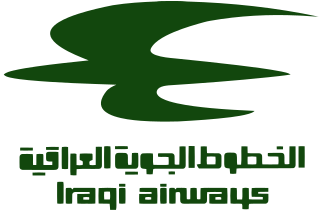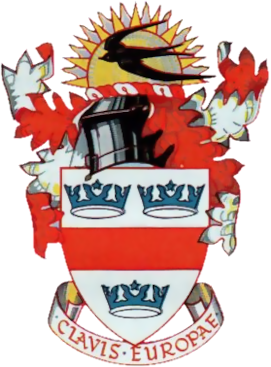
Iraqi Airways Company, operating as Iraqi Airways, is the national carrier of Iraq, headquartered on the grounds of Baghdad International Airport in Baghdad. It is the second oldest airline in the Middle East. Iraqi Airways operates domestic and regional services; its main base is Baghdad International Airport. Iraqi Airways has been on the list of air carriers banned in the European Union since 2015 due to failing to meet EU safety criteria.

The Bristol Type 175 Britannia is a retired British medium-to-long-range airliner built by the Bristol Aeroplane Company in 1952 to fly across the Commonwealth. During development two prototypes were lost and the turboprop engines proved susceptible to inlet icing, which delayed entry into service while solutions were sought.

British European Airways (BEA), formally British European Airways Corporation, was a British airline which existed from 1946 until 1974.

Ghana Airways Limited was the flag carrier of Ghana, with its main base of operation and hub at Kotoka International Airport in Accra. The airline ceased operations in 2004, although plans were discussed to revive it in 2020 in partnership with Egyptair.
This is a list of aviation-related events from 1958.

The Avro York was a British transport aircraft developed by Avro during the Second World War. The design was derived from the Avro Lancaster heavy bomber, several sections of the York and Lancaster being identical. Due to the importance of Lancaster production, York output proceeded slowly until 1944, after which a higher priority was placed upon transport aircraft.
Middle East Airlines – Air Liban S.A.L., more commonly known as Middle East Airlines (MEA), is the flag carrier of Lebanon, with its head office in Beirut, near Beirut–Rafic Hariri International Airport. It operates scheduled international flights to Asia, Europe, the Middle East, and Africa from its base at Rafic Hariri International Airport.

Tripoli International Airport is a closed international airport built to serve Tripoli, the capital city of Libya. The airport is located in the area of Qasr bin Ghashir, 24 kilometres (15 mi) from central Tripoli. It used to be the hub for Libyan Airlines, Afriqiyah Airways, and Buraq Air.

Hong Kong Airways was a flag carrier of British Hong Kong during the late 1940s and 1950s.

Northeast Airlines was an American airline based in Boston, Massachusetts that chiefly operated in the northeastern United States, and later to Canada, Florida, the Bahamas, Los Angeles and other cities. It was acquired by and merged into Delta Air Lines in August 1972.
East African Airways Corporation, more commonly known as East African Airways, was an airline jointly run by Kenya, Tanzania, and Uganda. It was set up on 1 January 1946, starting operations the same year. The airline was headquartered in the Sadler House in Nairobi, Kenya. The corporation was dissolved in 1977 amid deteriorated relations among the three countries.

British Eagle International Airlines was a major British independent airline that operated from 1948 until it went into liquidation in 1968. It operated scheduled and charter services on a domestic, international and transatlantic basis over the years.

Zambia Airways is the flag carrier of the Republic of Zambia. The airline is based in Lusaka, Zambia with its hub at Kenneth Kaunda International Airport.

The Canadair North Star is a 1940s Canadian development, for Trans-Canada Air Lines (TCA), of the Douglas DC-4. Instead of radial piston engines used by the Douglas design, Canadair used Rolls-Royce Merlin V12 engines to achieve a higher cruising speed of 325 mph (523 km/h) compared with the 227 mph (365 km/h) of the standard DC-4. Requested by TCA in 1944, the prototype flew on 15 July 1946. The type was used by various airlines and by the Royal Canadian Air Force (RCAF). It proved to be reliable but noisy when in service through the 1950s and into the 1960s. Some examples continued to fly into the 1970s, converted to cargo aircraft.
Central African Airways (CAA) was a supranational airline corporation serving as flag carrier for Southern Rhodesia, Northern Rhodesia and Nyasaland, which were organised as the Federation of Rhodesia and Nyasaland, also known as the Central African Federation, from 1953 to 1963. Based in Salisbury, it offered an extensive network of domestic passenger and cargo flights, as well as international services to major cities in Southern and Central Africa, and a route to London. In 1960, CAA owned 15 aircraft and had 1,155 employees.

Cambrian Airways was an airline based in the United Kingdom which ran operations from Cardiff Airport and Liverpool John Lennon Airport between 1935 and 1974. It was incorporated into British Airways when BOAC, BEA, Cambrian and Northeast merged on 1 April 1974.
Hunting-Clan Air Transport was a wholly private, British independent airline that was founded in the immediate post-World War II period. It began trading on 1 January 1946 as Hunting Air Travel Ltd. It was a subsidiary of the Hunting Group of companies, which had come from the shipping industry and could trace its history back to the 19th century. The newly formed airline's first operating base was at Bovingdon Airport in Southeast England. Its main activities were contract, scheduled and non-scheduled domestic and international air services that were initially operated with Douglas Dakota and Vickers Viking piston airliners from the company's Bovingdon base. A change of name to Hunting Air Transport occurred in 1951. By that time, the airline had emerged as one of the healthiest and most securely financed independent airlines in Britain. In October 1953, the firm's name changed to Hunting-Clan Air Transport, as a result of an agreement between the Hunting Group and the Clan Line group of companies to invest £500,000 each in a new company named Hunting-Clan Air Holdings Ltd, the holding company for the combined group's air transport interests. Apart from Hunting-Clan Air Transport itself, this included Field Aircraft Services Ltd, the Hunting group's aircraft maintenance arm. In 1960, Hunting-Clan Air Transport merged with the Airwork group to form British United Airways (BUA).

British Overseas Airways Corporation (BOAC) was the British state-owned airline created in 1939 by the merger of Imperial Airways and British Airways Ltd. It continued operating overseas services throughout World War II. After the passing of the Civil Aviation Act 1946, European and South American services passed to two further state-owned airlines, British European Airways (BEA) and British South American Airways (BSAA). BOAC absorbed BSAA in 1949, but BEA continued to operate British domestic and European routes for the next quarter century. The Civil Aviation Act 1971 merged BOAC and BEA, effective 31 March 1974, forming today's British Airways.


















